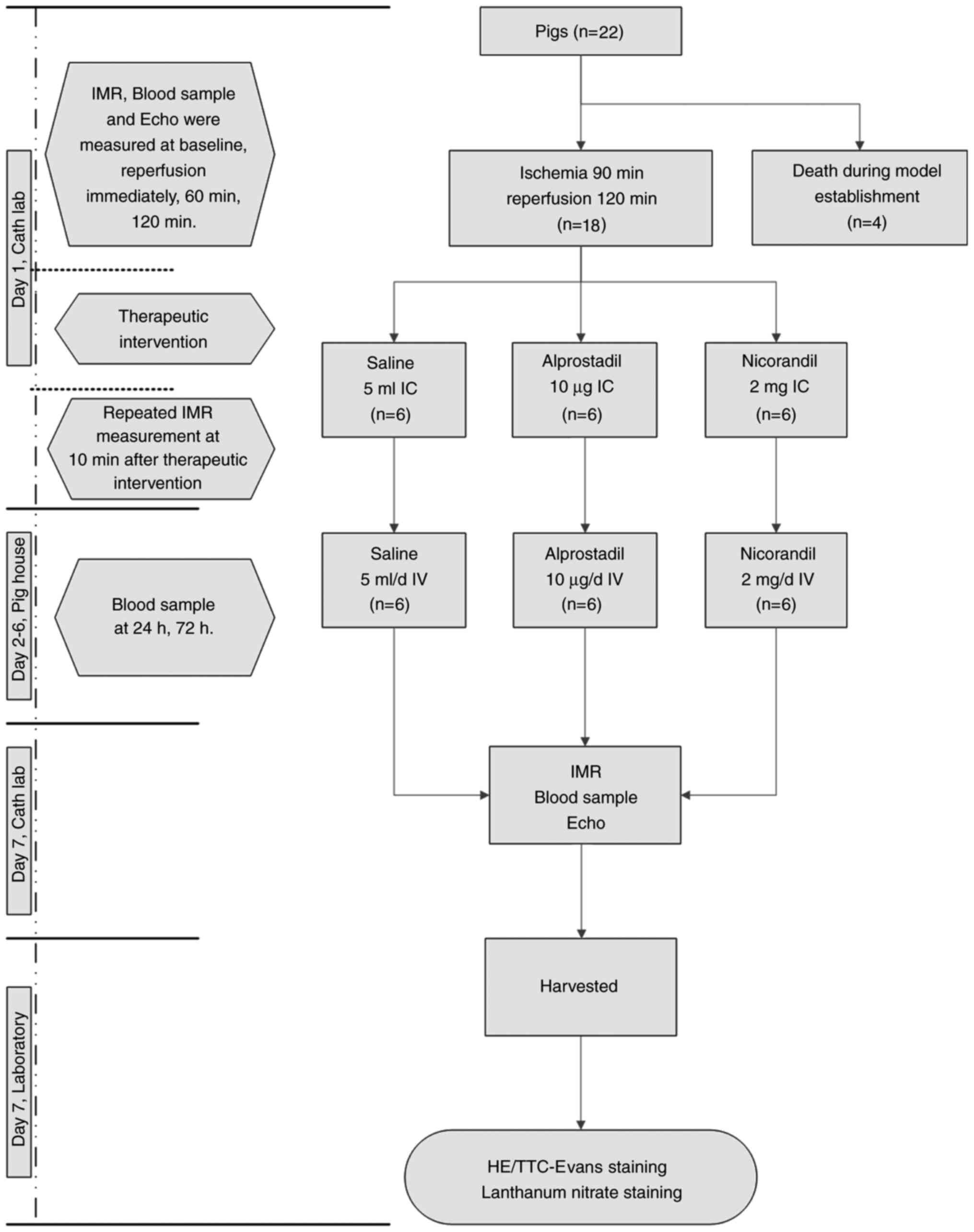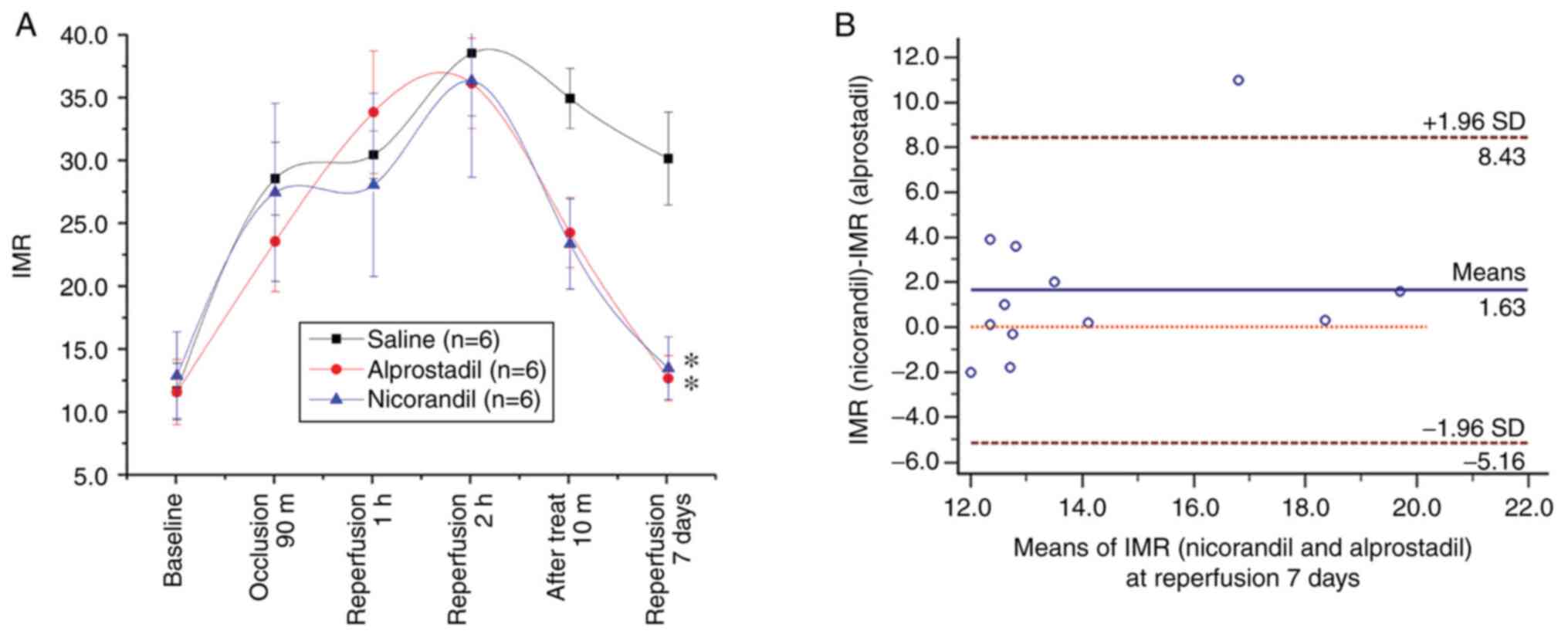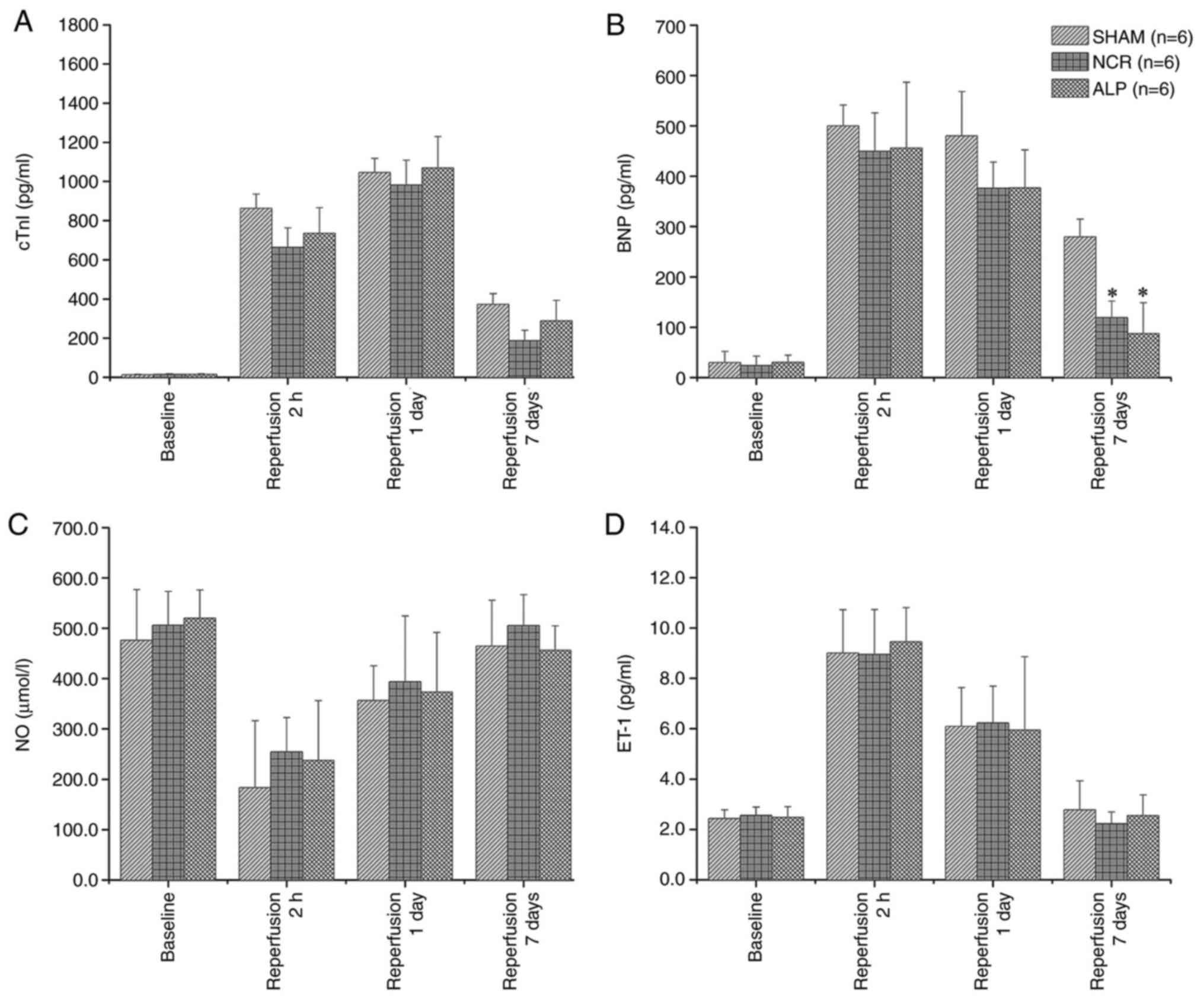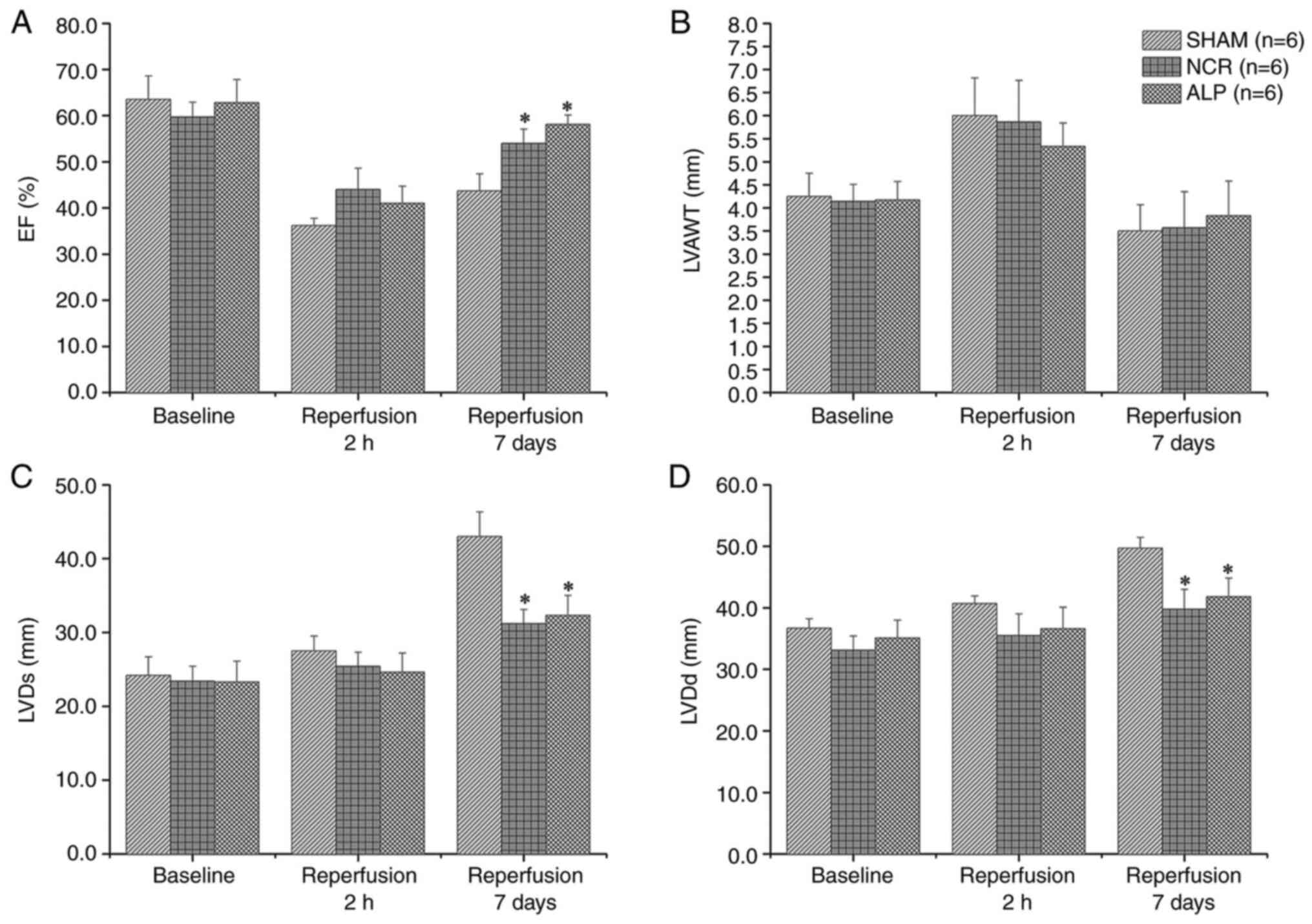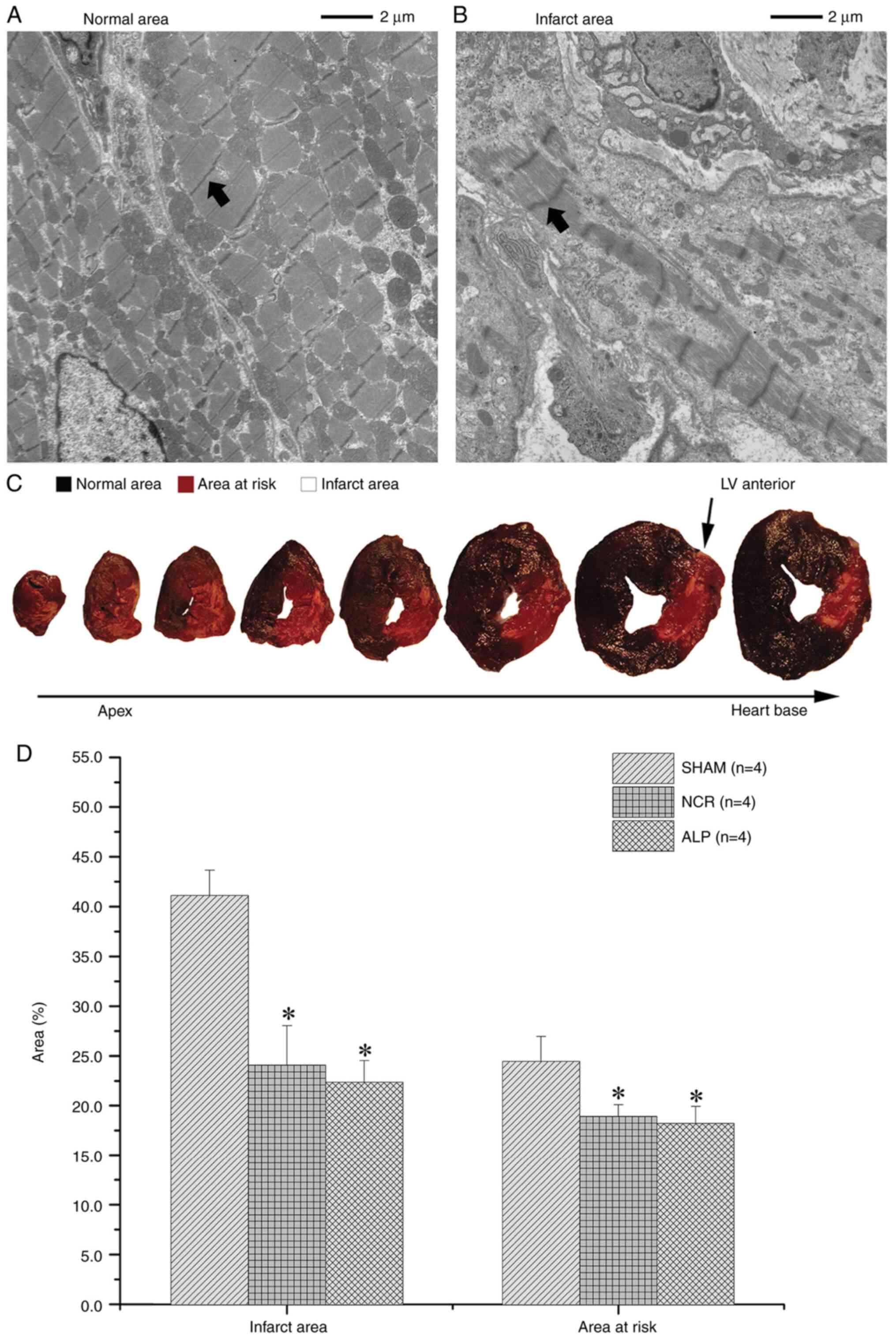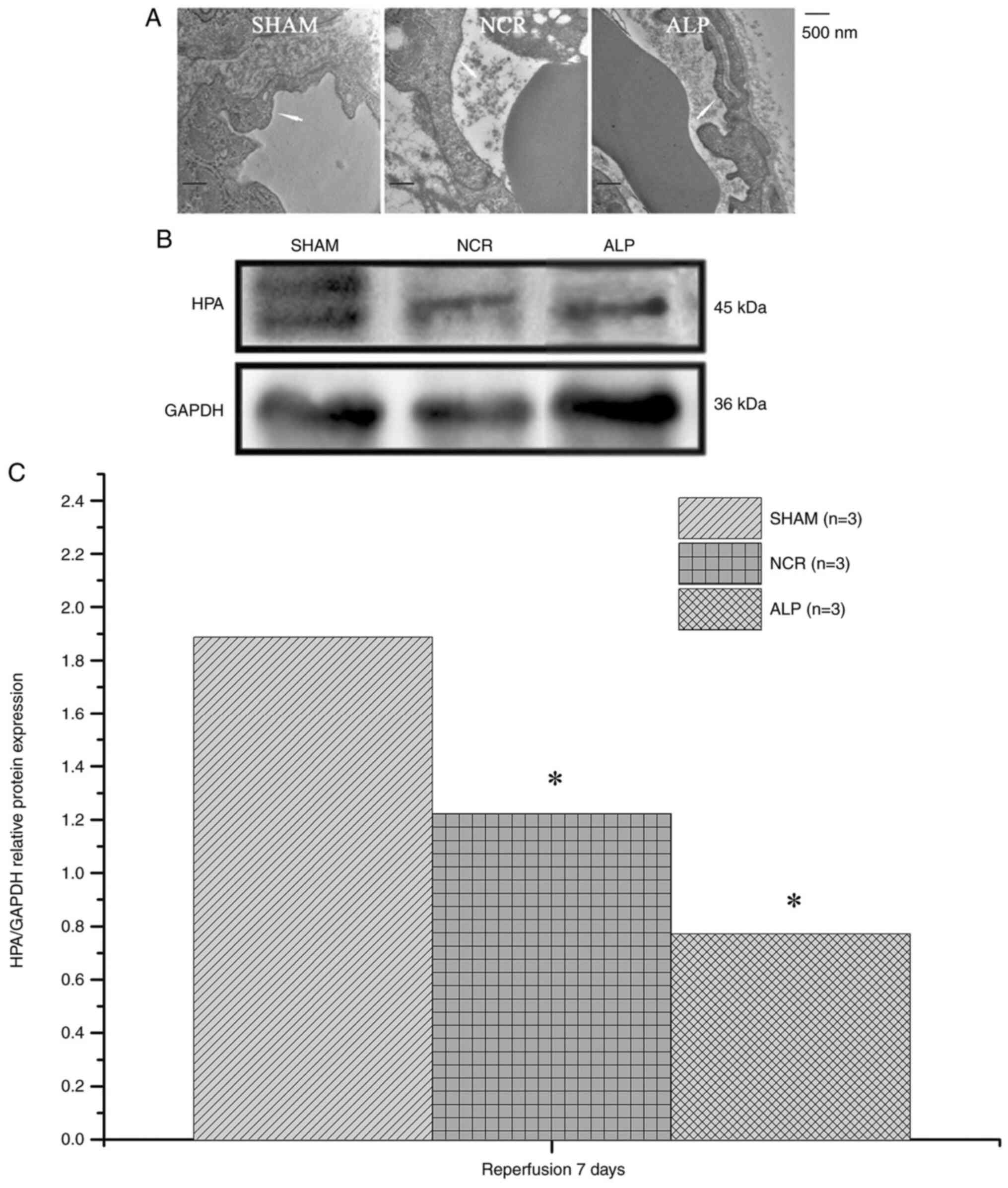|
1
|
Niccoli G, Burzotta F, Galiuto L and Crea
F: Myocardial No-Reflow in humans. J Am Coll Cardiol. 54:281–292.
2009.PubMed/NCBI View Article : Google Scholar
|
|
2
|
Fearon W, Shah M, Ng M, Brinton T, Wilson
A, Tremmel JA, Schnittger I, Lee DP, Vagelos RH, Fitzgerald PJ, et
al: Predictive value of the index of microcirculatory resistance in
patients with ST-segment elevation myocardial infarction. J Am Coll
Cardiol. 51:560–565. 2008.PubMed/NCBI View Article : Google Scholar
|
|
3
|
Ndrepepa G, Tiroch K, Fusaro M, Keta D,
Seyfarth M, Byrne RA, Pache J, Alger P, Mehilli J, Schömig A and
Kastrati A: 5-year prognostic value of no-reflow phenomenon after
percutaneous coronary intervention in patients with acute
myocardial infarction. J Am Coll Cardiol. 55:2383–2389.
2010.PubMed/NCBI View Article : Google Scholar
|
|
4
|
Hamirani YS, Wong A, Kramer CM and Salerno
M: Effect of microvascular obstruction and intramyocardial
hemorrhage by CMR on LV remodeling and outcomes after myocardial
infarction: A systematic review and meta-analysis. JACC Cardiovasc
Imaging. 7:940–952. 2014.PubMed/NCBI View Article : Google Scholar
|
|
5
|
Li J, Li X, Wang Q, Hu S, Wang Y, Masoudi
FA, Spertus JA, Krumholz HM and Jiang L: China PEACE Collaborative
Group. ST-segment elevation myocardial infarction in China from
2001 to 2011 (the China PEACE-Retrospective Acute Myocardial
Infarction Study): A retrospective analysis of hospital data.
Lancet. 385:441–451. 2015.PubMed/NCBI View Article : Google Scholar
|
|
6
|
Miyazawa A, Ikari Y, Tanabe K, Nakajima H,
Aoki J, Iijima R, Nakayama T, Hatori M, Nakazawa G, Tanimoto S, et
al: Intracoronary nicorandil prior to reperfusion in acute
myocardial infarction. EuroIntervention. 2:211–217. 2006.PubMed/NCBI
|
|
7
|
Matsuo H, Watanabe S, Watanabe T, Warita
S, Kojima T, Hirose T, Iwama M, Ono K, Takahashi H, Segawa T, et
al: Prevention of no-reflow/slow-flow phenomenon during rotational
atherectomy-A prospective randomized study comparing intracoronary
continuous infusion of verapamil and nicorandil. Am Heart J.
154:994.e1–6. 2007.PubMed/NCBI View Article : Google Scholar
|
|
8
|
Lee HC, An SG, Choi JH, Lee TK, Kim J, Kim
JH, Chun KJ, Hong TJ, Shin YW and Lee SK: Effect of intra-coronary
nicorandil administration prior to reperfusion in acute ST segment
elevation myocardial infarction. Circ J. 72:1425–1429.
2008.PubMed/NCBI View Article : Google Scholar
|
|
9
|
Kobatake R, Sato T, Fujiwara Y, Sunami H,
Yoshioka R, Ikeda T, Saito H and Ujihira T: Comparison of the
effects of nitroprusside versus nicorandil on the slow/no-reflow
phenomenon during coronary interventions for acute myocardial
infarction. Heart Vessels. 26:379–384. 2011.PubMed/NCBI View Article : Google Scholar
|
|
10
|
Galasso G, Schiekofer S, D'Anna C, Gioia
GD, Piccolo R, Niglio T, Rosa RD, Strisciuglio T, Cirillo P,
Piscione F and Trimarco B: No-reflow phenomenon: Pathophysiology,
diagnosis, prevention, and treatment. A review of the current
literature and future perspectives. Angiology. 65:180–189.
2014.PubMed/NCBI View Article : Google Scholar
|
|
11
|
Hülsmann M, Stefenelli T, Berger R, Sturm
B, Parkner A, Zuckermann A, Woloszczuk W and Pacher R: Response of
right ventricular function to prostaglandin E1 infusion predicts
outcome for severe chronic heart failure patients awaiting urgent
transplantation. J Heart Lung Transplant. 19:939–945.
2000.PubMed/NCBI View Article : Google Scholar
|
|
12
|
Friesenecker B, Tsai AG, Dunser MW,
Martini J, Hasibeder W and Intaglietta M: Lowered microvascular
vessel wall oxygen consumption augments tissue pO2 during
PgE1-induced vasodilation. Eur J Appl Physiol. 99:405–414.
2007.PubMed/NCBI View Article : Google Scholar
|
|
13
|
Gupta V, Rawat A and Ahsan F: Feasibility
study of aerosolized prostaglandin E1 microspheres as a noninvasive
therapy for pulmonary arterial hypertension. J Pharm Sci.
99:1774–1789. 2010.PubMed/NCBI View Article : Google Scholar
|
|
14
|
Fearon WF, Balsam LB, Farouque HM,
Caffarelli AD, Robbins RC, Fitzgerald PJ, Yock PG and Yeung AC:
Novel index for invasively assessing the coronary microcirculation.
Circulation. 107:3129–3132. 2003.PubMed/NCBI View Article : Google Scholar
|
|
15
|
McGeoch R, Watkins S, Berry C, Steedman T,
Davie A, Byrne J, Hillis S, Lindsay M, Robb S, Dargie H and Oldroyd
K: The index of microcirculatory resistance measured acutely
predicts the extent and severity of myocardial infarction in
patients with ST-segment elevation myocardial infarction. JACC
Cardiovasc Interv. 3:715–722. 2010.PubMed/NCBI View Article : Google Scholar
|
|
16
|
Cuculi F, De Maria GL, Meier P,
Dall'Armellina E, de Caterina AR, Channon KM, Prendergast BD,
Choudhury RP, Forfar JC, Kharbanda RK and Banning AP: Impact of
microvascular obstruction on the assessment of coronary flow
reserve, index of microcirculatory resistance, and fractional flow
reserve after ST-segment elevation myocardial infarction. J Am Coll
Cardiol. 64:1894–1904. 2014.PubMed/NCBI View Article : Google Scholar
|
|
17
|
Kilkenny C, Browne WJ, Cuthill IC, Emerson
M and Altman DG: Improving bioscience research reporting: The
ARRIVE guidelines for reporting animal research. PLoS Biol.
8(e1000412)2010.PubMed/NCBI View Article : Google Scholar
|
|
18
|
Lervik A, Raszplewicz J, Ranheim B, Solbak
S, Toverud SF and Haga HA: Dexmedetomidine or fentanyl?
Cardiovascular stability and analgesia during propofol-ketamine
total intravenous anaesthesia in experimental pigs. Vet Anaesth
Analg. 45:295–308. 2018.PubMed/NCBI View Article : Google Scholar
|
|
19
|
Duan T, Zhang J, Xiang D, Song R and Kong
R: Effect of combined anesthesia on Wuzhishan miniature pigs in
surgery lasting up to 8 hours. Chin J Comp Med. 28:80–85. 2018.(In
Chinese).
|
|
20
|
Liu X, Xie W, Liu P, Duan M, Jia Z, Li W
and Xu J: Mechanism of the cardioprotection of rhEPO pretreatment
on suppressing the inflammatory response in ischemia-reperfusion.
Life Sci. 78:2255–2264. 2006.PubMed/NCBI View Article : Google Scholar
|
|
21
|
Tachi M, Okada H, Matsuhashi N, Takemura
G, Suzuki K, Fukuda H, Niwa A, Tanaka T, Mori H, Hara A, et al:
Human colorectal cancer infrastructure constructed by the
glycocalyx. J Clin Med. 8(1270)2019.PubMed/NCBI View Article : Google Scholar
|
|
22
|
Stone GW, Webb J, Cox DA, Brodie BR,
Qureshi M, Kalynych A, Turco M, Schultheiss HP, Dulas D, Rutherford
BD, et al: Distal microcirculatory protection during percutaneous
coronary intervention in acute ST-segment elevation myocardial
infarction: A randomized controlled trial. JAMA. 293:1063–1072.
2005.PubMed/NCBI View Article : Google Scholar
|
|
23
|
Menees DS, Peterson ED, Wang Y, Curtis JP,
Messenger JC, Rumsfeld JS and Gurm HS: Door-to-balloon time and
mortality among patients undergoing primary PCI. N Engl J Med.
369:901–909. 2013.PubMed/NCBI View Article : Google Scholar
|
|
24
|
Kloner RA, Ganote CE and Jennings RB: The
‘No-Reflow’ phenomenon after temporary coronary occlusion in the
dog. J Clin Invest. 54:1496–1508. 1974.PubMed/NCBI View Article : Google Scholar
|
|
25
|
Bekkers SC, Yazdani SK, Virmani R and
Waltenberger J: Microvascular obstruction: Underlying
pathophysiology and clinical diagnosis. J Am Coll Cardiol.
55:1649–1660. 2010.PubMed/NCBI View Article : Google Scholar
|
|
26
|
Herrmann J, Kaski JC and Lerman A:
Coronary microvascular dysfunction in the clinical setting: From
mystery to reality. Eur Heart J. 33:2771–2781b. 2012.PubMed/NCBI View Article : Google Scholar
|
|
27
|
Niccoli G, Scalone G, Lerman A and Crea F:
Coronary microvascular obstruction in acute myocardial infarction.
Eur Heart J. 37:1024–1033. 2016.PubMed/NCBI View Article : Google Scholar
|
|
28
|
Bestehorn HP, Neumann FJ, Buttner HJ, Betz
P, Stürzenhofecker P, von Hodenberg E, Verdun A, Levai L, Monassier
JP and Roskamm H: Evaluation of the effect of oral verapamil on
clinical outcome and angiographic restenosis after percutaneous
coronary intervention: The randomized, double-blind,
placebo-controlled, multicenter Verapamil slow-release for
prevention of cardiovascular events after angioplasty (VESPA)
trial. J Am Coll Cardiol. 43:2160–2165. 2004.PubMed/NCBI View Article : Google Scholar
|
|
29
|
Van't Hof AW, Ten Berg J, Heestermans T,
Dill T, Funck RC, van Werkum W, Dambrink JH, Suryapranata H, van
Houwelingen G, Ottervanger JP, et al: Prehospital initiation of
tirofiban in patients with ST-elevation myocardial infarction
undergoing primary angioplasty (On-TIME 2): A multicentre,
double-blind, randomised controlled trial. Lancet. 372:537–546.
2008.PubMed/NCBI View Article : Google Scholar
|
|
30
|
Niccoli G, Rigattieri S, De Vita MR,
Valgimigli M, Corvo P, Fabbiocchi F, Romagnoli E, De Caterina AR,
La Torre G, Lo Schiavo P, et al: Open-Label, Randomized,
Placebo-Controlled evaluation of intracoronary adenosine or
nitroprusside after thrombus aspiration during primary percutaneous
coronary intervention for the prevention of microvascular
obstruction in acute myocardial infarction: The REOPEN-AMI study
(Intracoronary Nitroprusside Versus Adenosine in Acute Myocardial
Infarction). JACC Cardiovasc Interv. 6:580–589. 2013.PubMed/NCBI View Article : Google Scholar
|
|
31
|
Pizarro G, Fernández-Friera L, Fuster V,
Fernández-Jiménez R, García-Ruiz JM, García-Álvarez A, Mateos A,
Barreiro MV, Escalera N, Rodriguez MD, et al: Long-Term benefit of
early Pre-Reperfusion metoprolol administration in patients with
acute myocardial infarction: Results from the METOCARD-CNIC trial
(Effect of Metoprolol in Cardioprotection During an Acute
Myocardial Infarction). J Am Coll Cardiol. 63:2356–2362.
2014.PubMed/NCBI View Article : Google Scholar
|
|
32
|
Hillegass WB, Dean NA, Liao L, Rhinehart
RG and Myers PR: Treatment of no-reflow and impaired flow with the
nitric oxide donor nitroprusside following percutaneous coronary
interventions: Initial human clinical experience. J Am Coll
Cardiol. 37:1335–1343. 2001.PubMed/NCBI View Article : Google Scholar
|
|
33
|
Carrick D, Oldroyd KG, McEntegart M, Haig
C, Petrie MC, Eteiba H, Hood S, Owens C, Watkins S, Layland J, et
al: A randomized trial of deferred stenting versus immediate
stenting to prevent no- or slow-reflow in acute ST-segment
elevation myocardial infarction (DEFER-STEMI). J Am Coll Cardiol.
63:2088–2098. 2014.PubMed/NCBI View Article : Google Scholar
|
|
34
|
Kostic J, Djordjevic-Dikic A, Dobric M,
Milasinovic D, Nedeljkovic M, Stojkovic S, Stepanovic J, Tesic M,
Trifunovic Z, Zamaklar-Tifunovic D, et al: The effects of
nicorandil on microvascular function in patients with ST segment
elevation myocardial infarction undergoing primary PCI. Cardiovasc
Ultrasound. 13(26)2015.PubMed/NCBI View Article : Google Scholar
|
|
35
|
Jang HJ, Koo BK, Lee HS, Park JB, Kim JH,
Seo MK, Yang HM, Park KW, Nam CW, Doh JH and Kim HS: Safety and
efficacy of a novel hyperaemic agent, intracoronary nicorandil, for
invasive physiological assessments in the cardiac catheterization
laboratory. Eur Heart J. 34:2055–2062. 2013.PubMed/NCBI View Article : Google Scholar
|
|
36
|
Costa AD and Garlid KD: Intramitochondrial
signaling: Interactions among mitoKATP, PKCepsilon, ROS, and MPT.
Am J Physiol Heart Circ Physiol. 295:H874–H882. 2008.PubMed/NCBI View Article : Google Scholar
|
|
37
|
Ishii H, Ichimiya S, Kanashiro M, Amano T,
Imai K, Murohara T and Matsubara T: Impact of a single intravenous
administration of nicorandil before reperfusion in patients with
ST-Segment-Elevation myocardial infarction. Circulation.
112:1284–1288. 2005.PubMed/NCBI View Article : Google Scholar
|
|
38
|
Feld S, Li G, Amirian J, Felli P, Vaughn
WK, Accad M, Tolleson TR, Swenson C, Ostro M and Smalling RW:
Enhanced thrombolysis, reduced coronary reocclusion and limitation
of infarct size with liposomal prostaglandin E1 in a canine
thrombolysis model. J Am Coll Cardiol. 24:1382–1390.
1994.PubMed/NCBI View Article : Google Scholar
|
|
39
|
Huang CL, Wu YW, Wang SS, Tseng CD, Chiang
FT, Hsu KL, Lee CM and Tzen KY: Continuous intravenous infusion of
prostaglandin E1 improves myocardial perfusion reserve in patients
with ischemic heart disease assessed by positron emission
tomography: A pilot study. Ann Nucl Med. 25:462–468.
2011.PubMed/NCBI View Article : Google Scholar
|
|
40
|
Hildebrand F, Andruszkow H, Huber-Lang M,
Pape H and van Griensven M: Combined hemorrhage/trauma models in
pigs-current state and future perspectives. Shock. 40:247–273.
2013.PubMed/NCBI View Article : Google Scholar
|
|
41
|
Kumar M, Kasala ER, Bodduluru LN, Dahiya
V, Sharma D, Kumar V and Lahkar M: Animal models of myocardial
infarction: Mainstay in clinical translation. Regul Toxicol
Pharmacol. 76:221–230. 2016.PubMed/NCBI View Article : Google Scholar
|
|
42
|
De Maria GL, Cuculi F, Patel N, Dawkins S,
Fahrni G, Kassimis G, Choudhury RP, Forfar JC, Prendergast BD,
Channon KM, et al: How does coronary stent implantation impact on
the status of the microcirculation during primary percutaneous
coronary intervention in patients with ST-elevation myocardial
infarction? Eur Heart J. 36:3165–3177. 2015.PubMed/NCBI View Article : Google Scholar
|
|
43
|
Gensch C, Clever Y, Werner C, Hanhoun M,
Bohm M and Laufs U: Regulation of endothelial progenitor cells by
prostaglandin E1 via inhibition of apoptosis. J Mol Cell Cardiol.
42:670–677. 2007.PubMed/NCBI View Article : Google Scholar
|
|
44
|
Weiss T, Fischer D, Hausmann D and Weiss
C: Endothelial function in patients with peripheral vascular
disease: Influence of prostaglandin E1. Prostaglandins Leukot
Essent Fatty Acids. 67:277–281. 2002.PubMed/NCBI View Article : Google Scholar
|
|
45
|
Sirol M, Cescau A, Sideris G, Logeart D,
Dillinger JG, Mercadier JJ and Henry P: Index of microcirculatory
resistance as an early predictive factor of Lv remodeling after
reperfused myocardial infarction. J Am Coll Cardiol.
65(A1934)2015.
|
|
46
|
Wu CC, Wu CI, Wang WY and Wu YC: Low
concentrations of resveratrol potentiate the antiplatelet effect of
prostaglandins. Planta Med. 73:439–443. 2007.PubMed/NCBI View Article : Google Scholar
|
|
47
|
Baker AB, Groothuis A, Jonas M, Ettenson
DS, Shazly T, Zcharia E, Vlodavsky I, Seifert P and Edelman ER:
Heparanase alters arterial structure, mechanics, and repair
following endovascular stenting in mice. Circ Res. 104:380–387.
2009.PubMed/NCBI View Article : Google Scholar
|
|
48
|
Li JP and Vlodavsky I: Heparin, heparan
sulfate and heparanase in inflammatory reactions. Thromb Haemost.
102:823–828. 2009.PubMed/NCBI View Article : Google Scholar
|
|
49
|
Peterson SB and Liu J: Multi-faceted
substrate specificity of heparanase. Matrix Biol. 32:223–227.
2013.PubMed/NCBI View Article : Google Scholar
|
|
50
|
Baker AB, Gibson WJ, Kolachalama VB,
Golomb M, Indolfi L, Spruell C, Zcharia E, Vlodavsky I and Edelman
ER: Heparanase regulates thrombosis in vascular injury and
Stent-Induced flow disturbance. J Am Coll Cardiol. 59:1551–1560.
2012.PubMed/NCBI View Article : Google Scholar
|
|
51
|
Mooij HL, Cabrales P, Bernelot Moens SJ,
Xu D, Udayappan SD, Tsai AG, van der Sande MA, de Groot E,
Intaglietta M, Kastelein JJ, et al: Loss of function in heparan
sulfate elongation genes EXT1 and EXT 2 results in improved nitric
oxide bioavailability and endothelial function. J Am Heart Assoc.
3(e001274)2014.PubMed/NCBI View Article : Google Scholar
|
|
52
|
Kawamura T, Nara N, Kadosaki M, Inada K
and Endo S: Prostaglandin E1 reduces myocardial reperfusion injury
by inhibiting proinflammatory cytokines production during cardiac
surgery. Crit Care Med. 28:2201–2208. 2000.PubMed/NCBI View Article : Google Scholar
|
|
53
|
Vlodavsky I, Blich M, Li JP, Sanderson RD
and Ilan N: Involvement of heparanase in atherosclerosis and other
vessel wall pathologies. Matrix Biol. 32:241–251. 2013.PubMed/NCBI View Article : Google Scholar
|















